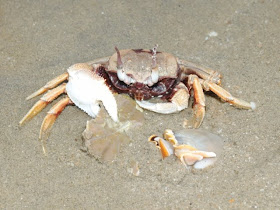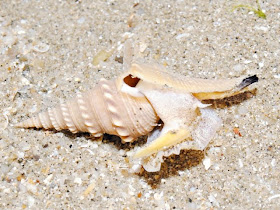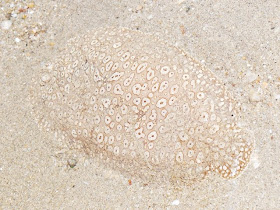We are back at the Lost Coast after close to two years! This is one trip that I have been really waiting for because our previous trip here during a not-so-low tide reveals that this is a special sandy shore. Special thanks to Travis, Ria, Alex and Jumari for making this trip possible.
We saw many rare creatures during the trip but none can compare to this large Astropecten sand star (Astropecten sp.) which I have never seen before! It is a beauty!
A way of identifying Astropecten sea stars would be to look at the arrangement of spines. Interestingly, there are five pairs of two spines (nearest to the centre of sea star) pointing upwards instead of sidewards. The blue margin and orangey red surface makes this sea star really gorgeous!
That's not all, this star has a orange underside unlike the other two kinds of Astropecten sea stars we see in Singapore.
Here is a closer look at the orangey tube feet.
Frequent shore explorers will know that the Painted sand stars (Astropecten sp.) found on the left of this photo can grow to quite a large size. This new star is even larger!
Here is a photo of the two Astropecten sea stars that we used to frequent find in our northern shores. They are the Plain sand stars (Astropecten indicus) on the left and the Painted sand stars (Astropecten sp.) on the right.
Another sea star that can also be found on this shore will be the Common sea stars (Archaster typicus).
Surprisingly, there were quite a number of echinoderm finds on this sandy shore! This is a pretty brittle star found by James with a pink underside.
Apart from the zillions of Cake sand dollars (Arachnoides placenta), the team also found two rarer Laganum sand dollars (Laganum depressum)!
Also a representative from the Phylum Echinodermata, this recently dead Keyhole sand dollar (Echinodiscus truncatus) was carried by a leaf porter crab. Ivan spotted it! It made me quite excited because it has been some years since I've seen one.
Interestingly, very few sea cucumbers were sighted by the team. We came across this tiny creature that looks like one.
So much about echinoderms (which are my favourites), snails were also extremely abundant on the Lost Coast. I have never seen so many Grey bonnet snails (Phalium glaucum) on one trip in my life before. Can you see the other two snails at the background. They are everywhere!
The bonnet snails have shells that can be slightly greyish or orangey in colour. The white siphon sticks out from in front.
As seen from Cyrene in the past, bonnet snails feed on cake sand dollars. It was amusing capturing this moment where the snail and a ghost crab was at the same time fighting over a sand dollar!
More rare snail finds include this Naked moon snails (Sinum sp.) which are rather flat. It has a flat shell and the large body is unable to retract into the shell completely when disturbed.
As there are many Button snails (Umbonium vestiarum) on this shore, it is natural to find their predators such as the various types of moon snails. Clockwise from top left: Oval moon snails (Polinices mammilla), Tiger moon snail (Natica tigrina), Ball moon snails (Polinices didyma) and Lined moon snail (Natica lineata).
Rarely do we find living turrid snails (Family Turridae). So it was great to be able to see this elegant snail on the shore.
This is one pretty snail which I have not seen for a long time! The Fig snail (Ficus variegata) is one which has nice pinkish body and a pear shaped shell. They have been previously sighted at East Coast shore.
Only previously seen once at Tanah Merah, there were quite a number of these special sea slugs on the lost coast! This is a Philine sp. as identified by Dr Bill when I checked with him in 2009.
I'll end off this blog post with a hermit crab that I don't think I've seen before. I found it near the water's edge.
It's amazing how we can still find new creatures after visiting our shores for so many times already. This is indeed a special (and remote) shore and I look forward to coming back again. :-)
It's amazing how we can still find new creatures after visiting our shores for so many times already. This is indeed a special (and remote) shore and I look forward to coming back again. :-)
























No comments:
Post a Comment